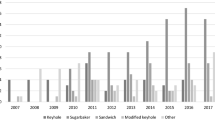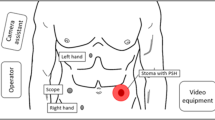Abstract
Introduction
Parastomal hernias are frequent and highly recurrent. The sandwich technique is a combination of the keyhole and Sugarbaker techniques, using a double intraperitoneal mesh. The objective of this study was to assess the outcomes of the sandwich technique, specifically focusing on recurrence rates.
Materials and methods
Observational retrospective study conducted in two tertiary referral centers in Catalonia, Spain. All consecutive patients who underwent parastomal hernia repair using the sandwich technique between 1st January 2016 and 31st December 2021 were included.
Results
A total of 38 patients underwent the laparoscopic sandwich technique for parastomal hernia repair. The overall recurrence rate was 7.9% (3/38), with a median follow-up of 39 months (IQR: 12.3–56.5). According to the EHS classification for parastomal hernia, there were 47.4% (18/38) type I defects, 10.5% (4/38) type II defects, 28.9% (11/38) type III defects, and 13.2% (5/38) type IV defects. The used mesh was predominantly TiMesh® (76.3%; 29/38), followed by DynaMesh® IPOM (23.7%; 9/38). Patients with recurrence exhibited higher rates of seroma, hematoma, surgical site infection, and one case of early recurrence attributed to mesh retraction. Consequently, postoperative complications emerged as the primary risk factor for hernia recurrence.
Conclusion
The sandwich technique demonstrated recurrence rates consistent with those reported in the existing literature.

Similar content being viewed by others
References
Mohiuddin S, Hollingworth W, Rajaretnam N et al (2021) Use of prophylactic mesh during initial stoma creation to prevent parastomal herniation: a systematic review and meta-analysis of randomised controlled trials. Colorectal Dis 23:2821–2833. https://doi.org/10.1111/codi.15849
Niu N, Du S, Yang D et al (2022) Risk factors for the development of a parastomal hernia in patients with enterostomy: a systematic review and meta-analysis. Int J Colorectal Dis 37:507–519. https://doi.org/10.1007/s00384-021-04068-5
North J, Osborne W (2017) ASCN UK Guideline: parastomal hernias. Br J Nurs 26:S6–S13. https://doi.org/10.12968/bjon.2017.26.22.S6
Zorraquino González Á (2017) Hernia paraestomal. Experiencia en una Sección de Cirugía de la Pared Abdominal. Rev Hispanoam Hernia 5:23–31. https://doi.org/10.20960/rhh.25
ACPGBI Parastomal Hernia Group (2018) Prevention and treatment of parastomal hernia: a position statement on behalf of the Association of Coloproctology of Great Britain and Ireland. Colorectal Dis 20:5–19. https://doi.org/10.1111/codi.14249
Antoniou SA, Agresta F, Garcia Alamino JM et al (2018) European Hernia Society guidelines on prevention and treatment of parastomal hernias. Hernia 22:183–198. https://doi.org/10.1007/s10029-017-1697-5
López-Cano M, Pereira JA, Rodrigues-Gonçalves V et al (2021) Parestomal hernia repair prospective observational study based on the Spanish Registry of Incisional Hernia (EVEREG). Cirugía Española (Engl Ed) 99:527–534. https://doi.org/10.1016/j.cireng.2021.06.016
Hansson BME, Slater NJ, van der Velden AS et al (2012) Surgical techniques for parastomal hernia repair: a systematic review of the literature. Ann Surg 255:685–695. https://doi.org/10.1097/SLA.0b013e31824b44b1
Mäkäräinen-Uhlbäck E, Vironen J, Falenius V et al (2021) Parastomal hernia: a retrospective nationwide cohort study comparing different techniques with long-term follow-up. World J Surg 45:1742–1749. https://doi.org/10.1007/s00268-021-05990-z
Berger D, Bientzle M (2007) Laparoscopic repair of parastomal hernias: a single surgeon’s experience in 66 patients. Dis Colon Rectum 50:1668–1673. https://doi.org/10.1007/s10350-007-9028-z
Köhler G, Mayer F, Wundsam H et al (2015) Changes in the surgical management of parastomal hernias over 15 years: results of 135 cases. World J Surg 39:2795–2804. https://doi.org/10.1007/s00268-015-3187-1
Wiessner R, Vorwerk T, Gehring A (2019) Laparoscopic repair for parastomal hernia with ongoing barbed suture followed by sandwich-technique: ‘Sandwich-plus-technique.’ J Min Access Surg 15:148. https://doi.org/10.4103/jmas.JMAS_236_17
Hashida H, Kumata Y, Kondo M et al (2021) Analysis of the outcome of laparoscopic repair for parastomal hernia using the sandwich technique. Indian J Surg 83:542–546. https://doi.org/10.1007/s12262-020-02316-6
Bertoglio C, Morini L, Maspero M et al (2021) From keyhole to sandwich: change in laparoscopic repair of parastomal hernias at a single centre. Surg Endosc 35:1863–1871. https://doi.org/10.1007/s00464-020-07589-2
von Elm E, Altman DG, Egger M et al (2008) The Strengthening the Reporting of Observational Studies in Epidemiology (STROBE) statement: guidelines for reporting observational studies. J Clin Epidemiol 61:344–349. https://doi.org/10.1016/j.jclinepi.2007.11.008
Śmietański M, Szczepkowski M, Alexandre JA et al (2014) European Hernia Society classification of parastomal hernias. Hernia 18:1–6. https://doi.org/10.1007/s10029-013-1162-z
Fortunova A, Berger D (2018) Quick, easy and work so efficiently: who doesn’t love a sandwich? Long-term results of the laparoscopic sandwich-repair of parastomal hernia. Surg Endosc 32:623. https://doi.org/10.1007/s00464-019-06728-8
Muysoms FE, Miserez M, Berrevoet F et al (2009) Classification of primary and incisional abdominal wall hernias. Hernia 13:407–414. https://doi.org/10.1007/s10029-009-0518-x
Dindo D, Demartines N, Clavien P-A (2004) Classification of surgical complications: a new proposal with evaluation in a cohort of 6336 patients and results of a survey. Ann Surg 240:205–213. https://doi.org/10.1097/01.sla.0000133083.54934.ae
Ozog Y, Konstantinovic ML, Werbrouck E et al (2011) Shrinkage and biomechanical evaluation of lightweight synthetics in a rabbit model for primary fascial repair. Int Urogynecol J 22:1099–1108. https://doi.org/10.1007/s00192-011-1440-1
Bittner R, Bain K, Bansal VK et al (2019) Update of guidelines for laparoscopic treatment of ventral and incisional abdominal wall hernias (International Endohernia Society (IEHS))—Part A. Surg Endosc 33:3069–3139. https://doi.org/10.1007/s00464-019-06907-7
Tandon A, Pathak S, Lyons NJR et al (2016) Meta-analysis of closure of the fascial defect during laparoscopic incisional and ventral hernia repair. Br J Surg 103:1598–1607. https://doi.org/10.1002/bjs.10268
Ayuso SA, Shao JM, Deerenberg EB et al (2021) Robotic Sugarbaker parastomal hernia repair: technique and outcomes. Hernia 25:809–815. https://doi.org/10.1007/s10029-020-02328-x
Pereira X, Lima DL, Friedmann P et al (2022) Robotic abdominal wall repair: adoption and early outcomes in a large academic medical center. J Robotic Surg 16:383–392. https://doi.org/10.1007/s11701-021-01251-2
Birolini C, Tanaka EY, De Miranda JS et al (2022) The early outcomes of complex abdominal wall reconstruction with polyvinylidene (PVDF) mesh in the setting of active infection: a prospective series. Langenbecks Arch Surg 407:3089–3099. https://doi.org/10.1007/s00423-022-02625-2
Pauli EM, Juza RM, Winder JS (2016) How I do it: novel parastomal herniorrhaphy utilizing transversus abdominis release. Hernia 20:547–552. https://doi.org/10.1007/s10029-016-1489-3
Jiang H, Thapa DM, Cai X et al (2021) Modified laparoscopic Sugarbaker repair of parastomal hernia with a totally extraperitoneal technique. Front Surg 8:740430. https://doi.org/10.3389/fsurg.2021.740430
Lambrecht JR (2021) Endoscopic preperitoneal parastomal hernia repair (ePauli repair): an observational study. Surg Endosc 35:1903–1907. https://doi.org/10.1007/s00464-020-08192-1
Muysoms FE, Antoniou SA, Bury K et al (2015) European Hernia Society guidelines on the closure of abdominal wall incisions. Hernia 19:1–24. https://doi.org/10.1007/s10029-014-1342-5
Author information
Authors and Affiliations
Corresponding author
Ethics declarations
Disclosures
Alberto G. Barranquero, Juan José Espert, María Magdalena Llompart Coll, Yolanda Maestre González, Cristina Gas Ruiz, Jorge Juan Olsina Kissler, and Rafael Villalobos Mori have no conflicts of interest or financial ties to disclose.
Additional information
Publisher's Note
Springer Nature remains neutral with regard to jurisdictional claims in published maps and institutional affiliations.
Rights and permissions
Springer Nature or its licensor (e.g. a society or other partner) holds exclusive rights to this article under a publishing agreement with the author(s) or other rightsholder(s); author self-archiving of the accepted manuscript version of this article is solely governed by the terms of such publishing agreement and applicable law.
About this article
Cite this article
Barranquero, A.G., Espert, J.J., Llompart Coll, M.M. et al. Analysis of recurrence and risk factors in laparoscopic sandwich technique for parastomal hernia repair. Surg Endosc 37, 9125–9131 (2023). https://doi.org/10.1007/s00464-023-10475-2
Received:
Accepted:
Published:
Issue Date:
DOI: https://doi.org/10.1007/s00464-023-10475-2




